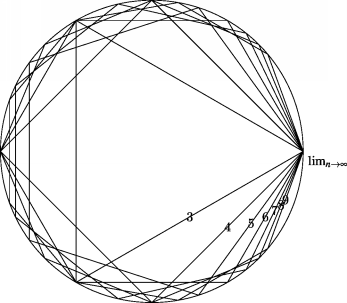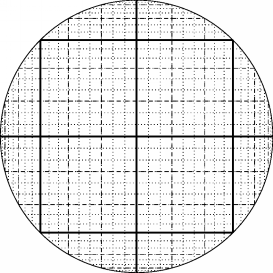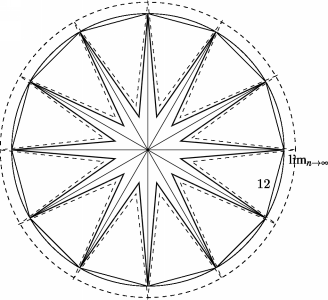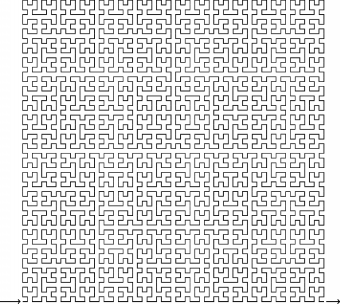7.3.1 The Problem of Infinity
Squaring the circle is also a problem proposed by ancient mathematicians; which is a challenge for constructing a square with the same area as a given circle, by using only a finite number of steps with compass and straightedge. The task was proven to be impossible in 1882, as a consequence of the Lindemann-Weierstrass theorem which proved that is a transcendental number, which means that it is non-algebraic and therefore non-constructible, rather than simply an algebraic irrational number. For this reason, the expression “squaring the circle” is often used as a metaphor for trying to do the impossible.
is a transcendental number, which means that it is non-algebraic and therefore non-constructible, rather than simply an algebraic irrational number. For this reason, the expression “squaring the circle” is often used as a metaphor for trying to do the impossible.
However, approximate squaring, to any given non-perfect accuracy, is possible in a finite number of steps, since there are many rational numbers arbitrarily close to . This is usually referred to as the quadrature of the circle, which describes approximate or numerical methods for finding the area of a circle, or the value of
. This is usually referred to as the quadrature of the circle, which describes approximate or numerical methods for finding the area of a circle, or the value of .
.

Figure 7.4: Fitting polygons in the circle. The first shape that can fit inside a circle is a unilateral triangle, and then a square with four sides, and so on, but the area of the circle is always larger than the area of these polygons, unless the polygon has infinite number of sides, which is impossible in the actual world.
The first integer approximation of is 3, while in fractions it can be approximated to, in order of increasing accuracy, 22/7, 333/106, 355/113, 52163/16604, 103993/33102, and 245850922/78256779, and the series is endless. As a decimal with the first 50 digits
is 3, while in fractions it can be approximated to, in order of increasing accuracy, 22/7, 333/106, 355/113, 52163/16604, 103993/33102, and 245850922/78256779, and the series is endless. As a decimal with the first 50 digits is equal to: 3.14159265358979323846264338327950288419716939937510, but the series is also endless.
is equal to: 3.14159265358979323846264338327950288419716939937510, but the series is also endless.
Using complex numbers and Euler’s identity, the association between imaginary powers of the natural logarithm and points on the unit circle centered at the origin in the complex plane is given by Euler’s formula:
and points on the unit circle centered at the origin in the complex plane is given by Euler’s formula: . Setting
. Setting in Euler’s formula results in Euler’s identity:
in Euler’s formula results in Euler’s identity: , or:
, or: .
.
Similarly, using the split-complex numbers, we can write Euler’s formula with the hyperbolic functions ( and
and ):
): , so the identity:
, so the identity: .
.
There are different complex numbers
different complex numbers satisfying
satisfying , and these are called the “n-th roots of unity”, given by this formula:
, and these are called the “n-th roots of unity”, given by this formula: , where
, where .
.
Squaring the circle is impossible in normal Euclidean real space, but there have been some serious claims of quadrature over certain non-Euclidean spaces, such as the hyperbolic plane, known as Bolyai-Lobachevskian geometry, but they may be not fully realistic, because there are actually no squares in the hyperbolic plane or any non-Euclidean space, and these quadratures mostly apply for certain situations only.
Therefore, in order to be able to square the circle in Euclidean geometry, we need to redefine space by taking into account the actual geometry of creation, or the genuinely-complex nature of time using the hyperbolic space, or the split-complex numbers as explained in chapter V. This is the only way we can calculate with finite number of quadratures, and as a bonus we can discover the reason behind dividing the circle into 360 degrees, and why
with finite number of quadratures, and as a bonus we can discover the reason behind dividing the circle into 360 degrees, and why .
.
The problem of finding the area under a curve is usually solved in calculus by integration, or by quadrature or squaring in numerical analysis which had been used before the techniques of calculus, that were introduced by Newton and Leibniz, as we described in chapter II. For example, as shown in Figures 7.4 and 7.5, the area of the circle equals the area of a polygon with equal sides when
equal sides when , which is impossible to achieve in real life. All these methods, therefore, rely on some kind of approximation, because when taking the limits into infinity we are automatically supposing that the dimensions of space, and time, are infinitely divisible.
, which is impossible to achieve in real life. All these methods, therefore, rely on some kind of approximation, because when taking the limits into infinity we are automatically supposing that the dimensions of space, and time, are infinitely divisible.
Therefore, the fundamental reason why it is impossible to square the circle in normal Euclidean space is because we are considering both space and time to be real, or uniform and infinitely divisible. In reality, the dimensions of space-time are hyperbolic as we have demonstrated in chapters V and VI, and we need two complementary directions of such hyperbolic time in order to make one real dimension of space, as we have seen in section 2, by using split-complex numbers. This means that multiplicity and dimensions are inevitably ruled by discrete time, because we can only think of dimensions as a result of our ability to move in time, even if it is only by abstract thought.
When we draw any shape, including the circle, as the simplest and most symmetrical shape, we are making a number of movements in various directions, and even when we try to imagine such objects we need at least two moments to conceive of their relative dimensions. Therefore, it is impossible to make these shapes perfectly smooth, because ultimately at some microscopic level, what looks like a smooth line or curve is actually made of a finite number of discrete points, polygons or angles, as it is shown in Figures 7.4 and 7.5.
Therefore, in order to calculate the area of a circle from a square, or vice versa, we should take into account the dimension of time as well as space. For example, when we draw a straight line, we are actually drawing a curve, because we must be moving the pen at some speed, so we have to take into account time dilation and length contraction according to Lorentz transformations. We can therefore make the appropriate calculations to find a suitable at which the square will appear as a circle when viewed from a reference frame moving at this speed, and therefore the area of the stationary square will be equal to the area of the circle factored according length contraction.

Figure 7.5: Filling the circle with squares. Obviously, it is impossible to make the curve of the circle perfectly smooth, because ultimately at some microscopic level, what looks like a smooth line or curve is actually made of a finite number of discrete points or angles. Also the circle is ultimately filled of squares that connect between the actual points of the granular space geometry, so it is impossible for the area of the circle to be exactly equal to all the squares inside it, unless the side of the square is infinitely small, which is impossible in the actual physical world.
However, as we have seen in chapter V, Lorentz transformations are equivalent to a rotation in the imaginary plane, since: , while
, while , and we have seen above that in the polar coordinates, where a unit circle is defined by:
, and we have seen above that in the polar coordinates, where a unit circle is defined by: , we could split this circle into two conjugate hyperbolas:
, we could split this circle into two conjugate hyperbolas: , which are symbolically represented in Figure 7.6, which means that in reality, when we take the hyperbolic duality nature of time into account, drawing a circle is equivalent to drawing a star that starts from the center to one point on the circumference, and then going back to the center before making the second point, and so on. This actually defines the inner part of the circle which represents the physical world that evolves in the imaginary direction of time, and the other= part is defined by the complementary dashed lines which represents the conjugate of the physical world, that is the psychical world. Each world alone can not define a perfect circle in a finite number of movements, but being complementary, together they do, because each one of them is the inverse of the other and when multiplied they produce the unit:
, which are symbolically represented in Figure 7.6, which means that in reality, when we take the hyperbolic duality nature of time into account, drawing a circle is equivalent to drawing a star that starts from the center to one point on the circumference, and then going back to the center before making the second point, and so on. This actually defines the inner part of the circle which represents the physical world that evolves in the imaginary direction of time, and the other= part is defined by the complementary dashed lines which represents the conjugate of the physical world, that is the psychical world. Each world alone can not define a perfect circle in a finite number of movements, but being complementary, together they do, because each one of them is the inverse of the other and when multiplied they produce the unit: .
.
In reality, therefore, both the physical and psychical worlds have discrete space-time structures, and perception or consciousness happens as a result of their instantaneous coupling that produces an absolute symmetrical and spherical space which is the image that formed by imagination. Physical material objects, as well as psychical objects such as information, are granular, and they are only approximated by imagination into real space or smooth surfaces. For this reason, we can see an image of a circle at once, but we can not draw a real perfect circle in finite time or finite number of steps.
In the actual extreme granular structure of space, the circle is composed of squares, as symbolically represented in Figure 7.5, because the minimum shape that can be created, or drawn on a plane space, in one instance of time is a square, and not a circle, and the minimum shape that can be created in three-dimensional space is a cube and not a sphere.
To make such a minimum square in the plane space, the Single Monad, or the geometrical point makes four physical movements, each one produces an abrupt rotation by
geometrical point makes four physical movements, each one produces an abrupt rotation by , which is what makes space genuinely complex. In reality, however, there are eight fundamental movements; four in the physical plane and four in the psychological plane, as also can be figured out from the depiction in Figure 7.1 which explain in when we talked about the hidden symmetry in section 2. For this reason, the ancients divided the circle into four quarters that make the 360 degrees as we shall explain in section 3.3.
, which is what makes space genuinely complex. In reality, however, there are eight fundamental movements; four in the physical plane and four in the psychological plane, as also can be figured out from the depiction in Figure 7.1 which explain in when we talked about the hidden symmetry in section 2. For this reason, the ancients divided the circle into four quarters that make the 360 degrees as we shall explain in section 3.3.

Figure 7.6: Splitting the circle into a star polygon and its complementary shape. This is what actually happens in reality when we draw a circle, because the points of space are sequentially created in the inner level of time, which makes space-time hyperbolic. Therefore, drawing a circle is equivalent to drawing a star that starts from the center to one point on the circumference, and then going back to the center before making the second point, and so on. This actually defines the inner part of the circle which represents the physical shape that evolves in the imaginary direction of time, and the other complementary part is defined by the dashed lines which represents the conjugate of the physical world, that is the psychical world. Each world alone can not define a perfect circle in a finite number of movements, but being complementary, together they do, because each one of them is the inverse of the other and when multiplied they produce the unit: .
.
It is also possible to fill the two-dimensional plane or the three-dimensional volume in one linear flow as it can be achieved through Hilbert curve, which is a continuous fractal space-filling curve first described by the German mathematician David Hilbert in 1891, as a variant of the space-filling Peano curves discovered by Giuseppe Peano in 1890. Although it is a curve, it can be shown that its fractal dimensions are two, which is called the Hausdorff dimension, that is the unit square, and its graph is a compact set homeomorphic to the closed unit interval.
Hilbert curve can be graphed with a certain cutoff approximation called the
called the approximation to the limiting curve, and then the Euclidean length of
approximation to the limiting curve, and then the Euclidean length of is
is which grows exponentially with
which grows exponentially with , while at the same time always being bounded by a square with a finite area as shown in Figure 7.7.
, while at the same time always being bounded by a square with a finite area as shown in Figure 7.7.

Figure 7.7: It is possible to fill the two-dimensional plane in one linear flow by this continuous fractal space-filling curve first described by the German mathematician David Hilbert in 1891.






















